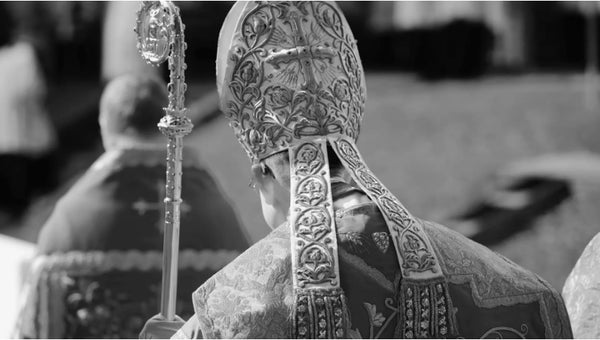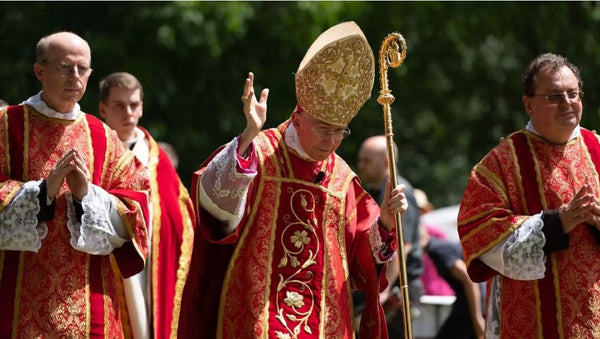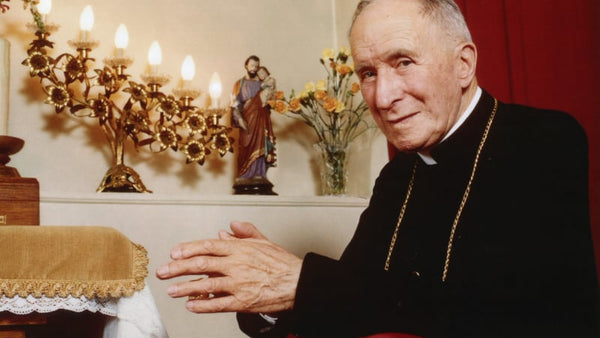3 – Fortiter in Re
A calm and balanced tone, however, is not an end in itself: it is a means to more effectively persuade people of the truth of one’s arguments and the truth to which we must always remain unshakably faithful. Let us examine – while we continue to compare it with Archbishop Lefebvre’s thoughts – what Bishop Schneider actually says about the Council:
Vatican II must be seen and received as it is and as it was really: a primarily pastoral council. This council had not the intention to propose new doctrines or to propose them in a definitive form”.
So far, the two men’s thoughts are identical. For Archbishop Lefebvre, too,
this Council has a particular character...it has a pastoral character and Pope John XXIII himself was careful to say that they did not wish to define any truths in this Council because they considered that so far, the truths we need for our faith have been sufficiently clear, and that he saw no need for the moment to make any new definitions”1.
Bishop Schneider then speaks of the attitude we should have towards the Council’s affirmations, and distinguishes three different types: those that are in conformity with the traditional teaching of the Church, those that are ambiguous, and those that are erroneous.
On the first, he claims that “in its statements the council confirmed largely the traditional and constant doctrine of the Church.”
To clarify ambiguous statements, he suggests the following criterion: “Those statements of Vatican II which are ambiguous must be read and interpreted according to the statements of the entire Tradition and of the constant Magisterium of the Church.”
And when the statements of the Council cannot be reconciled with preceding doctrine, and are truly erroneous,
the statements of the constant Magisterium (the previous councils and the documents of the Popes, whose content demonstrates being a sure and repeated tradition during centuries in the same sense) prevail over those objectively ambiguous or new statements... which difficultly concord with specific statements of the constant and previous Magisterium (e.g. the duty of the state to venerate publicly Christ, the King of all human societies, the true sense of the episcopal collegiality in relation to the Petrine primacy and the universal government of the Church, the noxiousness of all non-Catholic religions and their dangerousness for the eternal salvation of the souls).”
In addition to the examples given by Bishop Schneider, which are precisely the points that have always been criticized by the Society of St. Pius X (religious liberty, episcopal collegiality, and ecumenism), the approach he uses is very similar to that used by Archbishop Lefebvre, who so often repeated:
For me – for us, I think – saying that we see and judge the documents of the Council in the light of Tradition obviously means that we refuse those that go against Tradition, that we interpret those that are ambiguous in the light of Tradition, and that we accept those that are in keeping with Tradition”2.
The expression “hermeneutics of continuity” had not yet been formed, but the substance of this other way of “interpreting the Council in the light of Tradition” had already been proposed to Archbishop Lefebvre:
In the mind of the Holy Father and of Cardinal Ratzinger, if I have understood correctly, we should be able to incorporate the decrees of the Council into Tradition and figure out a way to include them at all costs. It is an impossible endeavor”3.
Bishop Schneider, too, distances himself from this sort of interpretation:
A blind application of the principle of the 'hermeneutics of continuity' does not help either, since thereby are created forced interpretations, which are not convincing and which are not helpful to arrive at a clearer understanding of the immutable truths of the Catholic faith and of its concrete application.”
Indeed, according to Archbishop Lefebvre, the basic problem with the churchmen who made and then applied the Council is that
they wanted it to be pastoral because of their instinctive horror for dogma, and to make it easier to officially introduce liberal ideas into a text of the Church. But once the operation is accomplished, they make a dogma of the Council, compare it to the Council of Nicaea, pretend it is like the other councils, if not superior to them”4.
Bishop Schneider says something along the same lines:
The problem of the current crisis of the Church consists partly in the fact that some statements of Vatican II – which are objectively ambiguous or those few statements, which are difficultly concordant with the constant magisterial tradition of the Church – have been infallibilisized. In this way, a healthy debate with a necessarily implicit or tacit correction was blocked...We must free ourselves from the chains of the absolutization and of the total infallibilization of Vatican II.”
4 – Mitis et Humilis Corde
So is everything perfect? That is not the point. The point is simply not to break the bruised reed or quench the smoking flax5. In short, to answer our initial question: even if his position is not perfect (but let he that is perfect cast the first stone), Bishop Schneider is without the shadow of a doubt – all the more so after this latest article which is of capital importance, since in it he explicitly condemns the principal errors of the Council and highlights their connection to the present crisis – one of the churchmen Bishop Fellay was talking about, “who protest, not as loudly as us, not as publicly as us, but as strongly as us on the level of ideas, they protest against the novelties”, and who are a “very important element in this battle”. It is also clear that his protests are also becoming more and more public.
The attitude that we Catholics faithful to Tradition – including those of the first hour, who (to their great merit) had the strength from the very start and without any hesitation to clearly stand up against today’s errors – the attitude that we must have towards these people who come back little by little, but more and more clearly to Tradition (all the more so when they are successors of the Apostles), must not be the attitude of the 4th century Luciferians, but that described extremely clearly by Bishop Alfonso de Galarreta in his sermon in Ecône for the priestly ordinations on June 29, 2017:
There is a good that did not use to exist, but that is starting to come. It is a good reaction from valuable laymen, priests, bishops, and cardinals…Yes, it is a minority, and sometimes the reactions are a little timid, or only go halfway. But still, they are real and healthy reactions, that go along the lines of the Faith, of Tradition, of the restoration of the Faith, the defense of the Church and of the priesthood of Our Lord. And at this, which is a sign of Our Lord’s assistance to His Church, we cannot but rejoice; we cannot but encourage it. The Society’s goal is the sanctification not only of its members, but the sanctification of priests in general. And this is an immense field for apostolate. So we have to take advantage – prudently of course, that is obvious – of these apostolic openings. And they should encourage us, too”.
In this way we will be truly faithful to the venerated founder of the Society of St. Pius X, Archbishop Lefebvre, who was always suaviter in modo and fortiter in re. And we will be faithful, too, to the patron saint of our seminaries, St. Thomas Aquinas: healthy Thomism has always known how to take the good no matter where it comes from (to build his philosophy, St. Thomas did not hesitate to use the pagan Aristotle – to the great scandal of the learned men of his times). But above all, we will be faithful to Our Lord Jesus Christ, “meek and humble of heart”6, who in His conversation with the scribe who still had a long way to go, but showed that he had grasped the essential and had a heart open to the Truth7, did not say to him: “See, you are one of the many conservative scribes who only know how to quote the precepts of the law by heart”, but rather, with a voice full of charity: “You are not far from the kingdom of God.”
- 1. Archbishop M. Lefebvre, Spiritual conference given in Ecône on June 28, 1975, in Vatican II. L’autorité d’un concile en question, op. cit., p. 15.
- 2. Conference given in Ecône on January 10, 1983.
- 3. Ibid.
- 4. Abp Marcel Lefebvre, I Accuse the Council, Angelus Press, pg. xiii.
- 5. See Mt. 12:20.
- 6. See Mt. 11:29.
- 7. See Mk. 12:28-34.





Angelus Press
Author